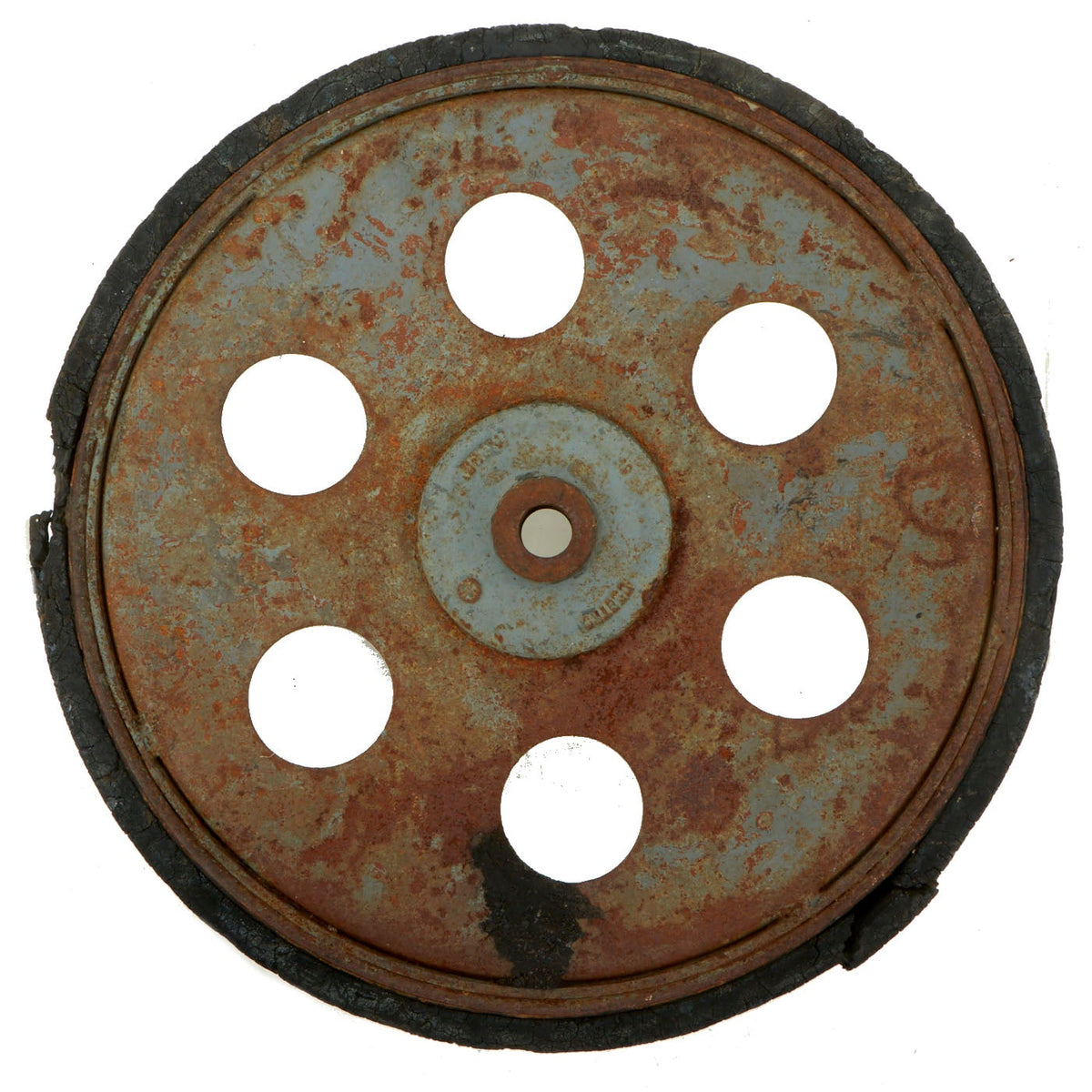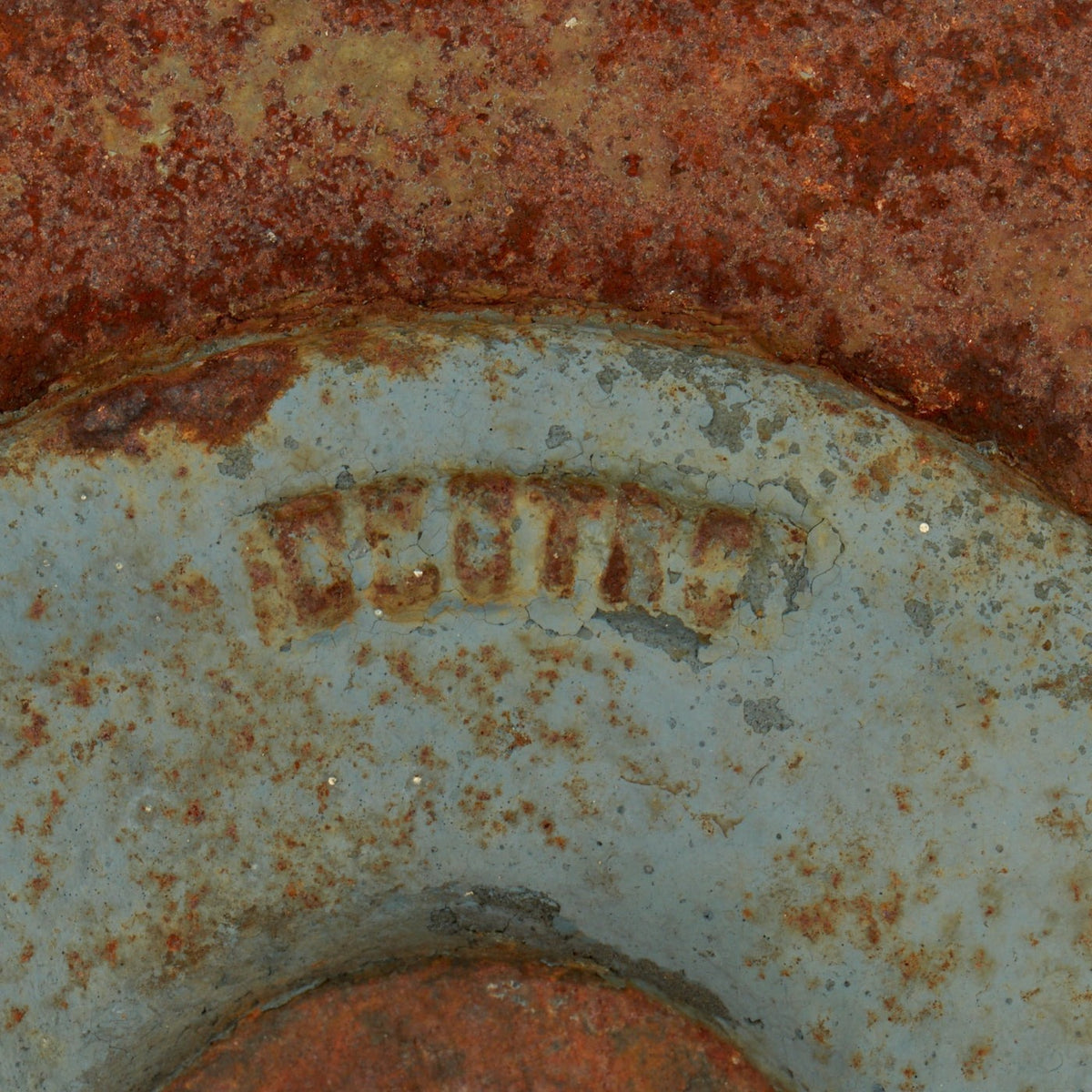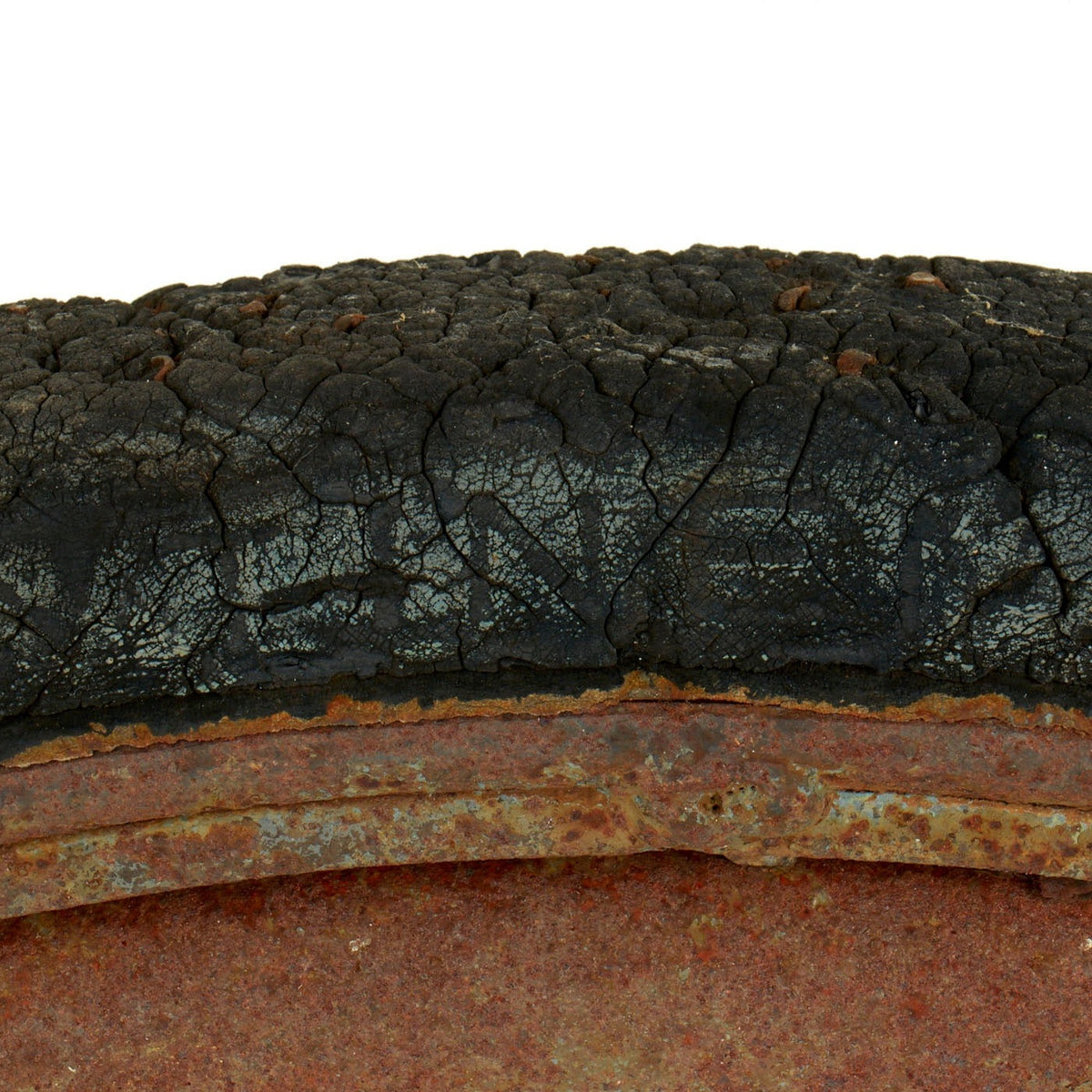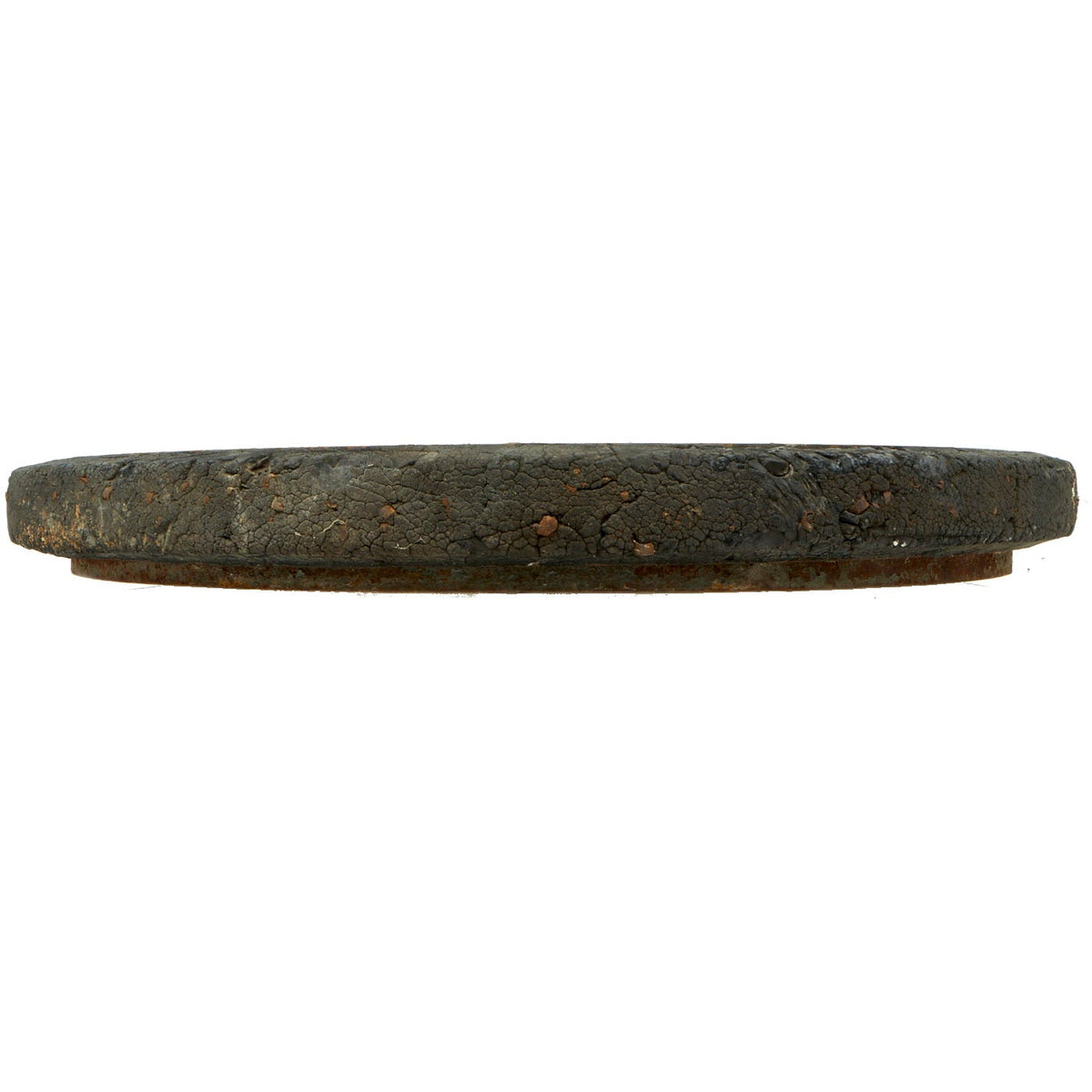Original German WWII German Army SdKfz 251 Half Track Road Wheel – dated 1939 Original Items
$ 895,00 $ 223,75
Original Item: Only One Available. This road wheel was for the Sonderkraftfahrzeug (Special Motor Vehicle) halftrack which was a German armored personnel carrier designed by the Hanomag company, in Hanover, Germany. This wheel features a thick rubber tread going around the circumference of the steel wheel. The rubber shows definite signs of the wheel being used, it is cracked and has deep tears and sections missing. There is no significant damage to the steel and retains approximately 30% or less of it’s original paint. There are markings around the central hub, including a 1939 date. The approximate weight is 60 pounds (27kgs) and the approximate measurements are 23” x 23” x 2”. This road wheel would be a wonderful addition to any WWII armored artifacts collection!
The Sd.Kfz. 251 (Sonderkraftfahrzeug 251) half-track was a World War II German armored personnel carrier designed by the Hanomag company, based on its earlier, unarmored Sd.Kfz. 11 vehicle. The Sd.Kfz. 251 was designed to transport the Panzergrenadier (German mechanized infantry) into battle. Sd.Kfz. 251s were the most widely produced German half-tracks of the war, with at least 15,252 vehicles and variants produced by seven manufacturers. Some sources state that the Sd.Kfz. 251 was commonly referred to simply as “Hanomags” by both German and Allied soldiers after the manufacturer of the vehicle. German officers referred to them as SPW (Schützenpanzerwagen, or armored infantry vehicle) in their daily orders and memoirs.
There were four main model modifications (Ausführung A through D), which formed the basis for at least 22 variants. The initial idea was for a vehicle that could be used to transport a single squad of 10 panzergrenadiers to the battlefield protected from enemy small arms fire, and with some protection from artillery fire. In addition, the standard mounting of at least one MG 34 or MG 42 machine gun allowed the vehicle to provide suppressive fire for the rifle squad both while they dismounted and in combat.
The armour plates were designed to provide protection against standard rifle/ machine gun bullets (like the 7.92×57mm Mauser bullet). The front-facing plates were 14.5mm thick; the sides were steeply angled, V-shape 8mm thick plates. This level of armour provided protection against normal (non-tungsten) rifle AP rounds, which could pierce about 8mm of vertical armour.
Positive aspects of the open top included greater situational awareness and faster egress by the infantry, as well as the ability to throw grenades and fire over the top of the fighting compartment as necessary while remaining under good horizontal cover. The downside, as with all armored personnel carriers of the era, was a major vulnerability to all types of plunging fire; this included indirect fire from mortars and field artillery, as well as small arms fire from higher elevated positions, lobbed hand grenades, Molotov cocktails, and strafing by enemy aircraft. The early production models of this vehicle were issued to the 1st Panzer Division in 1939.
These vehicles were meant to enable Panzergrenadiere to accompany panzers and provide infantry support as required. In practice, there were never enough of them to go around, and most Panzergrenadier units had to make do with trucks for transport.
In August 1943, Romania acquired a total of 27 armored half-tracks, of both the 251 and 250 types followed in 1944 by 251 type and other types of armored cars to convert two cavalry divisions into armored or mechanized divisions. Sd.Kfz. 251s were known as SPW mijlociu (“medium SPW”) in Romanian service, while Sd.Kfz. 250s were referred to as SPW ușor (“light SPW”).
The Army of the Independent State of Croatia received 15 Sd.Kfz. 251 in spring 1944 and the Ustashe Militia received 12 in autumn 1944.
Fast Shipping with Professional Packaging
Thanks to our longstanding association with UPS FedEx DHL, and other major international carriers, we are able to provide a range of shipping options. Our warehouse staff is expertly trained and will wrap your products according to our exact and precise specifications. Prior to shipping, your goods will be thoroughly examined and securely secured. We ship to thousands clients each day across multiple countries. This shows how we're dedicated to be the largest retailer on the internet. Warehouses and distribution centres can be located throughout Europe as well as the USA.
Note: Orders with more than one item will be assigned a processing date depending on the item.
Before shipping before shipping, we'll conduct a thorough inspection of the items you have ordered. Today, the majority of orders will be delivered within 48 hours. The delivery time will be between 3-7 days.
Returns
The stock is dynamic and we cannot completely manage it because multiple stakeholders are involved, including our factory and warehouse. So the actual stock may alter at any time. It's possible that you may not receive your order once the order has been made.
Our policy is valid for a period of 30 days. If you don't receive the product within 30 days, we are not able to issue a refund or an exchange.
You can only return an item if it is unused and in the same state as the day you received it. You must have the item in its original packaging.
Related products
Uncategorized
Uncategorized
Angolan Rebel 1970s era 60mm Inert Display Mortar from Angolan Civil War Original Items
Uncategorized
Uncategorized
Uncategorized
Uncategorized
Uncategorized
Uncategorized
Band of Brothers ORIGINAL GERMAN WWII Le. F.H. 18 10.5cm ARTILLERY PIECE Original Items
Uncategorized
Uncategorized
Armored Burgonet Helmet & Polearm from Scottish Castle Leith Hall Circa 1700 Original Items
Uncategorized
Uncategorized
Uncategorized
Uncategorized
Uncategorized
Uncategorized
Uncategorized
Uncategorized













































































